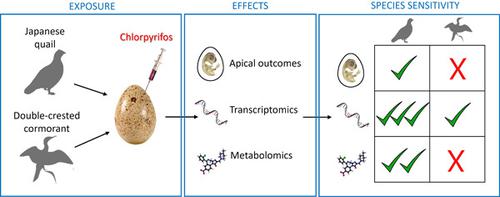当前位置:
X-MOL 学术
›
Environ. Toxicol. Chem.
›
论文详情
Our official English website, www.x-mol.net, welcomes your
feedback! (Note: you will need to create a separate account there.)
Using Transcriptomics and Metabolomics to Understand Species Differences in Sensitivity to Chlorpyrifos in Japanese Quail and Double-Crested Cormorant Embryos
Environmental Toxicology and Chemistry ( IF 3.6 ) Pub Date : 2021-07-22 , DOI: 10.1002/etc.5174 Jean-Pierre Desforges 1 , Elena Legrand 1 , Emily Boulager 1 , Peng Liu 1 , Jianguo Xia 1 , Heather Butler 2 , Bharat Chandramouli 3 , Jessica Ewald 1 , Niladri Basu 1 , Markus Hecker 4 , Jessica Head 1 , Doug Crump 5
Environmental Toxicology and Chemistry ( IF 3.6 ) Pub Date : 2021-07-22 , DOI: 10.1002/etc.5174 Jean-Pierre Desforges 1 , Elena Legrand 1 , Emily Boulager 1 , Peng Liu 1 , Jianguo Xia 1 , Heather Butler 2 , Bharat Chandramouli 3 , Jessica Ewald 1 , Niladri Basu 1 , Markus Hecker 4 , Jessica Head 1 , Doug Crump 5
Affiliation

|
Modern 21st-century toxicity testing makes use of omics technologies to address critical questions in toxicology and chemical management. Of interest are questions relating to chemical mechanisms of toxicity, differences in species sensitivity, and translation of molecular effects to observable apical endpoints. Our study addressed these questions by comparing apical outcomes and multiple omics responses in early–life stage exposure studies with Japanese quail (Coturnix japonica) and double-crested cormorant (Phalacrocorax auritus), representing a model and ecological species, respectively. Specifically, we investigated the dose-dependent response of apical outcomes as well as transcriptomics and metabolomics in the liver of each species exposed to chlorpyrifos, a widely used organophosphate pesticide. Our results revealed a clear pattern of dose-dependent disruption of gene expression and metabolic profiles in Japanese quail but not double-crested cormorant at similar chlorpyrifos exposure concentrations. The difference in sensitivity between species was likely due to higher metabolic transformation of chlorpyrifos in Japanese quail compared to double-crested cormorant. The most impacted biological pathways after chlorpyrifos exposure in Japanese quail included hepatic metabolism, oxidative stress, endocrine disruption (steroid and nonsteroid hormones), and metabolic disease (lipid and fatty acid metabolism). Importantly, we show consistent responses across biological scales, suggesting that significant disruption at the level of gene expression and metabolite profiles leads to observable apical responses at the organism level. Our study demonstrates the utility of evaluating effects at multiple biological levels of organization to understand how modern toxicity testing relates to outcomes of regulatory relevance, while also highlighting important, yet poorly understood, species differences in sensitivity to chemical exposure. Environ Toxicol Chem 2021;40:3019–3033. © 2021 SETAC
中文翻译:

利用转录组学和代谢组学了解日本鹌鹑和双冠鸬鹚胚胎对毒死蜱敏感性的物种差异
现代 21 世纪的毒性测试利用组学技术来解决毒理学和化学管理中的关键问题。感兴趣的是与毒性化学机制、物种敏感性差异以及分子效应转化为可观察的顶端终点有关的问题。我们的研究通过比较日本鹌鹑 ( Coturnix japonica ) 和双冠鸬鹚 ( Phalacrocorax auritus),分别代表模型和生态物种。具体来说,我们研究了暴露于毒死蜱(一种广泛使用的有机磷杀虫剂)的每个物种的顶端结果的剂量依赖性反应以及肝脏中的转录组学和代谢组学。我们的研究结果揭示了日本鹌鹑基因表达和代谢谱的剂量依赖性破坏的明显模式,但在相似毒死蜱暴露浓度下没有双冠鸬鹚。与双冠鸬鹚相比,日本鹌鹑的毒死蜱代谢转化率较高可能是物种间敏感性的差异。日本鹌鹑接触毒死蜱后受影响最大的生物途径包括肝脏代谢、氧化应激、内分泌紊乱(类固醇和非类固醇激素)、和代谢疾病(脂质和脂肪酸代谢)。重要的是,我们在生物尺度上表现出一致的反应,表明基因表达和代谢物谱水平的显着破坏导致生物体水平的可观察到的顶端反应。我们的研究证明了评估组织的多个生物学水平的影响以了解现代毒性测试如何与监管相关性结果相关的效用,同时也强调了重要但知之甚少的物种对化学暴露敏感性的差异。环境毒物化学2021;40:3019–3033。© 2021 SETAC
更新日期:2021-07-22
中文翻译:

利用转录组学和代谢组学了解日本鹌鹑和双冠鸬鹚胚胎对毒死蜱敏感性的物种差异
现代 21 世纪的毒性测试利用组学技术来解决毒理学和化学管理中的关键问题。感兴趣的是与毒性化学机制、物种敏感性差异以及分子效应转化为可观察的顶端终点有关的问题。我们的研究通过比较日本鹌鹑 ( Coturnix japonica ) 和双冠鸬鹚 ( Phalacrocorax auritus),分别代表模型和生态物种。具体来说,我们研究了暴露于毒死蜱(一种广泛使用的有机磷杀虫剂)的每个物种的顶端结果的剂量依赖性反应以及肝脏中的转录组学和代谢组学。我们的研究结果揭示了日本鹌鹑基因表达和代谢谱的剂量依赖性破坏的明显模式,但在相似毒死蜱暴露浓度下没有双冠鸬鹚。与双冠鸬鹚相比,日本鹌鹑的毒死蜱代谢转化率较高可能是物种间敏感性的差异。日本鹌鹑接触毒死蜱后受影响最大的生物途径包括肝脏代谢、氧化应激、内分泌紊乱(类固醇和非类固醇激素)、和代谢疾病(脂质和脂肪酸代谢)。重要的是,我们在生物尺度上表现出一致的反应,表明基因表达和代谢物谱水平的显着破坏导致生物体水平的可观察到的顶端反应。我们的研究证明了评估组织的多个生物学水平的影响以了解现代毒性测试如何与监管相关性结果相关的效用,同时也强调了重要但知之甚少的物种对化学暴露敏感性的差异。环境毒物化学2021;40:3019–3033。© 2021 SETAC











































 京公网安备 11010802027423号
京公网安备 11010802027423号